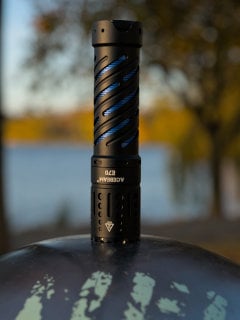This proprietary battery that Nitecore uses for all their latest generation tactical flashlights is the reason why I don’t buy or recommend them. It would have been easy to avoid these batteries.
Software developer from Germany with interests in programming, electronics, flashlights, calculators, writing instruments and various outdoor activities.
Visit my website for more info and updates.
See also: /u/SammysHP@lemmy.world
- 13 Posts
- 17 Comments

 1·2 years ago
1·2 years agoPut your hand in front of a 120 W bulb. Does it get warm?
Question is: What do you want to achieve by using a black body radiator? It won’t give you any fancy colors, just a pretty smooth spectrum.

 1·2 years ago
1·2 years agoSeven levels of brightness for the white channel, two for R/G/B/UV. Only one color at a time. Next to the RGB disco mode there’s also a red SOS, a read beacon and a white strobe.

 2·2 years ago
2·2 years agoYou can order the dual channel D4v2 with a deep red channel (660nm) and UV channel. ;)
Get it with the additional 18350 tube and optionally magnet in the tailcap. Costs more or less the same as the MiX-7, but only comes with two channels and has no internal charging. On the other hand it will have Anduril.
It will look like this: https://www.reddit.com/r/Hanklights/comments/16ans11/dual_channel_uv_d4kd4v2kr4/


 2·2 years ago
2·2 years agoIndeed, if you want RGB with more power than just aux LEDs, it might be a good choice (althout RGB has just two brightness levels). It’s also a great high CRI + UV candidate (alternatively you could consider a dual channel Emisar D4v2 with 519A and UV).

 1·2 years ago
1·2 years agoI don’t really like the input lag on the switch which is unusual for a “tactical” light
Which input lag do you mean? When it press the switch, my light turns on immediately.

 1·2 years ago
1·2 years agoDon’t compare the flashlights you’ll find here in c/flashlight with these cheap flashlights with fake lumen ratings. 😉

 1·2 years ago
1·2 years agoHuh? That never happened with any of my flashlights. Mechanical tail switches are pretty reliable.

 1·2 years ago
1·2 years agoIt performs OK, a little hard to press completely, though. Momentary mode works great, but it requires some force to press the switch completely. Apart from that it is reliable and relatively pocket-safe.

 4·2 years ago
4·2 years agoThere is also an image showing the laser engraving:

If you want to go professional, there isn’t much choice. Either The Sofirn/BLF LT1 or the smaller Sofirn LT1S Pro. Both have the Anduril operating system with a very complex, but also very powerful UI, they have adjustable color temperature and brightness – both either stepped or smooth – and the LT1S Pro even has a red channel!
Awesome! I think c/flashlight is a really great alternative to r/flashlight, especially if more people would post here.
And thanks for the giveaway!

 2·2 years ago
2·2 years agoWurkkos TS12, compact 14500 thrower:

 3·2 years ago
3·2 years agoYes, you could (theoretically) use an emulator for the microcontroller. I tried it a few times. And it isn’t fun. It takes a lot of effort to simulate all inputs, outputs are hard to interpret and all kind of effects of the real light aren’t reproduced.
In reality we flash the build onto a flashlight and try it. Sometimes it’s only a prototype, disassembled. And rarely it’s an actual devboard which has all relevant parts of the flashlight nicely accessible (basically the microcontroller with required electronics, regulated power supply, low power LED to see the output, several LEDs for aux and button and the switch itself).

 0·2 years ago
0·2 years agoPracticality depends on your preference. It’s heavy, some people say it stinks. But scratches don’t make it look ugly and it ages nicely with time.

Hmm… seltsamer Effekt: Mein Beitrag ist auf anderen Instanzen vorhanden, aber hier – von wo er ursprünglich stammt – ist er verschwunden: https://lemmy.world/post/10106501